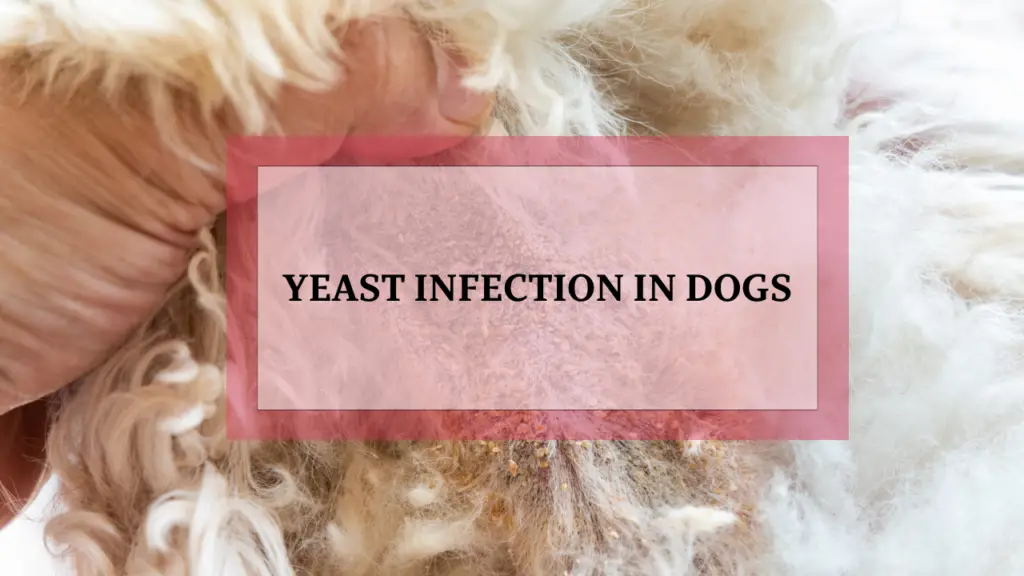What is a Yeast Infection in Dogs?
A yeast infection in dogs is a common skin condition caused by an overgrowth of yeast, a type of fungus naturally found on a dog’s skin and in their ears. Under normal conditions, yeast exists in small, harmless amounts. However, when a dog’s immune system is compromised, or their skin environment changes (due to moisture, allergies, or underlying health issues), yeast can multiply rapidly, leading to an infection.
How Yeast Infections Affect Dogs
Yeast infections primarily affect a dog’s ears, paws, skin folds, and groin area, where conditions are warm and moist—ideal for yeast growth. The infection can cause itchiness, redness, discomfort, and a distinct musty odor. In severe cases, untreated yeast infections may lead to secondary bacterial infections, making the condition more complicated to treat.
Yeast vs. Bacterial Infections
Many pet owners confuse yeast infections with bacterial skin infections because they share similar symptoms. However, there are key differences:
| Feature | Yeast Infection | Bacterial Infection |
| Cause | Overgrowth of yeast (fungus) | Bacteria such as Staphylococcus |
| Odor | Musty, corn chip-like smell | No specific odor, sometimes foul-smelling pus |
| Discharge | Dark brown, sticky, waxy buildup | Yellow or green pus, scabs, sores |
| Itchiness | Severe itching, paw licking, ear scratching | Itching and pain, often localized to wounds |
| Treatment | Antifungal medications, medicated baths | Antibiotics, antibacterial ointments |
Why Yeast Infections Are Common in Dogs
Some dog breeds are more prone to yeast infections due to their skin folds, floppy ears, or predisposition to allergies. Breeds such as Basset Hounds, Cocker Spaniels, Bulldogs, and Golden Retrievers tend to develop yeast infections more frequently.
Veterinarian Insight: “Yeast infections in dogs are often a secondary issue caused by an underlying problem like allergies or hormone imbalances. Treating the root cause is essential for long-term management.” – Dr. Sarah Thompson, DVM
Signs Your Dog Might Have a Yeast Infection
- Frequent scratching or biting at the skin
- A corn chip-like smell or musty odor
- Red, inflamed skin or ears
- Dark brown waxy buildup in the ears
- Hair loss in affected areas
- Thickened, elephant-like skin in chronic cases
What Causes Yeast Infections in Dogs?
A yeast infection in dogs doesn’t occur randomly—it usually results from an underlying issue that disrupts the natural balance of yeast on a dog’s skin. Understanding these causes is crucial for prevention and effective treatment.
1. Allergies (Food & Environmental)
Allergies are one of the most common triggers for yeast infections in dogs. They can cause inflammation, excessive scratching, and changes in skin pH, which create an ideal environment for yeast to grow.
- Food Allergies: Certain ingredients like chicken, beef, dairy, and grains can cause an allergic reaction, weakening the skin’s defenses.
- Environmental Allergies: Pollen, dust mites, mold, and household chemicals can trigger allergies, leading to chronic skin irritation.
- Flea Allergies: Even a few flea bites can cause severe itching and inflammation, which may lead to a secondary yeast infection.
Fact: Studies suggest that 50% of dogs with chronic yeast infections also have underlying allergies.
2. Moisture and Humidity
Yeast thrives in warm, damp environments. Dogs that live in humid climates or frequently swim are at a higher risk. Floppy-eared dogs, like Cocker Spaniels and Labrador Retrievers, are especially prone to yeast infections because moisture gets trapped inside their ears.
Tips to Prevent Moisture-Related Yeast Infections
✅ Dry your dog’s ears after swimming or bathing.
✅ Use a pet-safe drying solution or ear wipes.
✅ Keep skin folds clean and dry, especially in brachycephalic breeds like Bulldogs.
3. Weakened Immune System
A compromised immune system allows yeast to grow unchecked. Common conditions that can weaken immunity include:
- Autoimmune diseases
- Long-term steroid use
- Cancer or chemotherapy treatments
- Chronic infections or illnesses
Dogs with weak immune systems often suffer from recurrent yeast infections that require long-term management.
4. Hormonal Imbalances
Hormones play a significant role in skin health. When a dog’s hormones are out of balance, yeast overgrowth can occur.
- Hypothyroidism: A condition where the thyroid gland produces insufficient hormones, leading to dry, flaky skin and increased yeast growth.
- Cushing’s Disease: Excessive production of cortisol, which weakens the immune system and disrupts skin health.
Symptoms of hormone-related yeast infections include:
📌 Chronic ear infections
📌 Repeated skin infections despite treatment
📌 Thinning coat or hair loss
5. Antibiotics and Medications
While antibiotics are essential for treating bacterial infections, they can kill beneficial bacteria that help regulate yeast levels. This can lead to an imbalance, allowing yeast to overgrow rapidly.
🔍 Risk Factors:
- Long-term antibiotic use
- Overuse of corticosteroids
- Frequent use of antifungal medications without addressing the root cause
6. Diet and Poor Nutrition
A poor diet high in carbohydrates, sugars, and processed ingredients can feed yeast, worsening infections. Some commercial dog foods contain excessive starch, which converts to sugar in the body and promotes yeast growth.
Best Diet for Dogs Prone to Yeast Infections
✅ High-protein, low-carb diet
✅ Fresh, whole foods (lean meats, fish, and vegetables)
✅ Coconut oil (natural antifungal properties)
✅ Probiotics to support gut health
Symptoms of Yeast Infections in Dogs
Recognizing the symptoms of a yeast infection in dogs is essential for early intervention and treatment. Yeast infections can affect the ears, skin, and paws, leading to discomfort and worsening health issues if left untreated.
1. Common Signs of a Yeast Infection
Yeast infections have distinct symptoms that differentiate them from other skin or ear conditions. Below are the most common signs:
| Symptom | Description |
| Itchy Skin | Excessive scratching, licking, or chewing, especially in affected areas. |
| Red or Inflamed Skin | Visible irritation, sometimes with swelling or sores. |
| Greasy, Oily Coat | A waxy buildup on the skin, often seen in breeds prone to skin problems. |
| Thickened or Darkened Skin | Chronic yeast infections can cause skin thickening, leading to a “rhinoceros” texture. |
| Hair Loss | Patches of missing fur due to excessive scratching or inflammation. |
| Unpleasant Odor | A strong, musty, or “corn chip” smell is a telltale sign of yeast overgrowth. |
| Ear Infections | Frequent head shaking, ear scratching, or a foul-smelling discharge. |
| Brown Discharge (Ears or Paws) | Wax-like debris in the ears or dark, reddish-brown stains between the toes. |
| Hyperpigmentation | Darkened skin, especially in areas of chronic irritation. |
Fact: Some dog breeds, like West Highland White Terriers, Dachshunds, and Basset Hounds, are genetically predisposed to chronic yeast infections due to their skin structure and ear shape.
2. Symptoms Based on Affected Area
Yeast infections can develop anywhere on the body, but some areas are more prone to overgrowth.
🐶 Yeast Infection in Dog Ears
📌 Persistent head shaking or tilting
📌 Reddish, inflamed ear canals
📌 Foul-smelling discharge (brown or yellow)
📌 Sensitivity or pain when touched
Note: Ear yeast infections are often mistaken for bacterial ear infections. A vet can confirm the cause with a cytology test (examining ear debris under a microscope).
🐾 Yeast Infection in Dog Paws
📌 Constant licking of paws
📌 Brown or rusty-red discoloration between toes
📌 Thick, cracked paw pads
📌 Foul odor (similar to corn chips)
Yeast infections in the paws can make walking painful and may lead to secondary bacterial infections.
🐕 Yeast Infection on Dog Skin (Body, Belly, Armpits, Skin Folds)
📌 Red, irritated patches of skin
📌 Hair loss around infected areas
📌 Oily or greasy coat
📌 Thickened or scaly skin in chronic cases
Certain breeds with deep skin folds—like Bulldogs, Shar Peis, and Pugs—are at higher risk for yeast infections in skin folds because of trapped moisture.
3. How to Differentiate Yeast Infections from Other Skin Issues
Yeast infections can be confused with bacterial infections, mites, and allergies. Below is a comparison of common skin conditions:
| Condition | Key Symptoms | Differences from Yeast Infection |
| Bacterial Infection | Pus-filled sores, crusty lesions | Less odor, may require antibiotics |
| Mange (Mites) | Severe itching, hair loss, skin thickening | Often caused by parasites, confirmed via skin scrape |
| Allergies | Itching, watery eyes, sneezing | May involve seasonal triggers, food, or environment |
| Ringworm (Fungal Infection) | Circular bald patches, crusty skin | Highly contagious, often mistaken for yeast |
Diagnosing Yeast Infections in Dogs
Accurate diagnosis is crucial before starting treatment for a yeast infection in dogs. Many skin conditions share similar symptoms, so identifying the root cause helps ensure the correct treatment.
1. Veterinary Examination: The First Step
A vet will begin by examining the dog’s skin, ears, paws, and body folds to check for:
✅ Redness, inflammation, or thickened skin
✅ Foul-smelling discharge from the ears or paws
✅ Excessive licking, scratching, or head shaking
✅ Dark brown or waxy debris in affected areas
In addition to a physical exam, vets perform diagnostic tests to confirm the presence of yeast.
2. Common Tests for Diagnosing Yeast Infections
| Diagnostic Test | How It Works | Purpose |
| Cytology (Microscope Exam) | The vet collects a sample from the skin or ears using a cotton swab, presses it onto a slide, and stains it for microscopic examination. | Confirms the presence of Malassezia yeast and its concentration. |
| Skin Scraping | A small skin sample is taken and analyzed for mites, bacteria, or fungal infections. | Differentiates yeast infections from mange, ringworm, or bacterial infections. |
| Fungal Culture | A sample is placed in a lab dish to see if yeast grows. | Identifies the exact yeast strain affecting the dog. |
| Tape Impression Test | Clear tape is pressed against the affected area, then stained and examined under a microscope. | Quick way to detect yeast and skin bacteria. |
| Wood’s Lamp Test | A UV light is shined on the dog’s skin or fur. | Helps rule out ringworm, which glows under UV light. |
Fact: Yeast infections are often secondary infections, meaning they occur due to an underlying condition like allergies, hormonal imbalances, or immune system issues.
3. Identifying the Underlying Cause
If a dog experiences recurrent yeast infections, vets may perform additional tests, such as:
📌 Blood tests to check for diabetes or hypothyroidism
📌 Allergy tests to identify food or environmental allergens
📌 Hormone panels to evaluate thyroid and adrenal function
Best Treatments for Yeast Infections in Dogs
Treating yeast infections in dogs requires a combination of veterinary treatments and home remedies to eliminate the infection and prevent recurrence. The right treatment depends on the severity and location of the infection.
Veterinary Treatments
For moderate to severe yeast infections, veterinarians prescribe medications and topical treatments to kill yeast overgrowth effectively.
Antifungal Shampoos and Sprays
🛁 Medicated shampoos containing ketoconazole, chlorhexidine, or miconazole help eliminate yeast from the skin.
✔️ How to use:
- Bathe the dog 2-3 times per week for 4-6 weeks.
- Allow the shampoo to sit on the skin for 5-10 minutes before rinsing.
- Use antifungal sprays or wipes between baths for extra relief.
✔️ Best for:
- Skin infections (greasy, flaky skin)
- Paw yeast infections
Fact: Chlorhexidine-based wipes are excellent for cleaning wrinkles, paws, and ears in dogs prone to yeast infections.
Prescription Antifungal Medications (Oral & Topical)
💊 For severe or recurring yeast infections, veterinarians prescribe oral antifungal medications like:
✔ Ketoconazole – Broad-spectrum antifungal but may affect liver enzymes.
✔ Fluconazole – Effective for skin and ear infections.
✔ Itraconazole – Works well for chronic yeast overgrowth.
Topical creams and ointments may also be prescribed for localized infections, especially on the paws or belly.
📌 Important Note:
- Long-term use of oral antifungals requires liver monitoring through blood tests.
- These medications should not be used without veterinary supervision.
Ear Drops for Yeast Infections in Ears
🐶 Yeast infections in dog ears require prescription ear drops that contain antifungal and anti-inflammatory ingredients.
✔ Common ear medications:
- Mometamax – Contains antifungal, antibacterial, and steroid components.
- Clotrimazole drops – Effective for Malassezia yeast infections.
- Otomax – Treats both bacterial and yeast ear infections.
How to apply ear drops:
- Clean the ear canal with a veterinary-approved cleaner.
- Apply prescribed drops as directed (usually 1-2 times per day).
- Gently massage the base of the ear to distribute the medication.
Tip: Do not use cotton swabs inside the ear canal, as they can push debris deeper.
Home Remedies for Yeast Infections in Dogs
For mild yeast infections, natural remedies can help restore skin balance and prevent yeast from spreading.
Apple Cider Vinegar Rinse
🍏 Apple cider vinegar (ACV) has natural antifungal properties that help balance skin pH.
✔ How to use:
- Mix equal parts water and ACV in a spray bottle.
- Apply to affected areas (avoid open wounds).
- Use as an ear cleaner (diluted with water).
📌 Caution: ACV should not be used on broken skin as it may cause irritation.
Coconut Oil and Antifungal Essential Oils
🥥 Coconut oil contains lauric acid, which helps fight yeast naturally.
✔ How to use:
- Apply extra virgin coconut oil directly to affected areas.
- Mix a few drops of antifungal essential oils (tea tree, oregano, lavender) into the oil for added benefits.
📌 Caution: Tea tree oil is toxic to dogs if ingested. Always dilute and use with caution.
Probiotics and Dietary Changes
A yeast infection in dogs often starts in the gut, so fixing internal imbalances is key.
✔ Add probiotic supplements with Lactobacillus and Bifidobacterium strains.
✔ Feed a low-carb diet, as yeast thrives on sugar and starch.
✔ Include antifungal foods like coconut oil, oregano, and turmeric in meals.
Fact: Dogs on high-carb diets (kibble with corn, wheat, rice) are more prone to yeast infections.
How to Prevent Yeast Infections in Dogs
Preventing dog yeast infections requires consistent care, including proper nutrition, hygiene, and immune system support.
Proper Diet and Nutrition
Diet plays a crucial role in yeast overgrowth prevention.
✔ Low-carb, anti-inflammatory diet
- Avoid kibble with corn, wheat, soy, or rice.
- Opt for fresh, whole-food diets with lean meats and healthy fats.
✔ Avoid processed foods and sugar
- Sugar feeds yeast!
- Avoid dog treats with artificial flavors and fillers.
✔ Beneficial supplements
- Probiotics – Improve gut health and balance yeast.
- Omega-3 fatty acids – Reduce inflammation and skin irritation.
Case Study: A French Bulldog with chronic yeast infections saw a 90% improvement after switching to a raw, high-protein diet with probiotics.
Good Hygiene Practices
Keeping your dog clean and dry reduces yeast buildup.
✔ Regular bathing with antifungal shampoo
- Bathe weekly with chlorhexidine or miconazole shampoo.
- Dry thoroughly, especially skin folds and paws.
✔ Keeping ears dry and clean
- Use ear cleaners with drying agents like boric acid.
- Avoid excessive moisture, especially after swimming.
✔ Wiping paws after walks
- Yeast thrives in moist environments.
- Use antifungal wipes on paws and between toes.
Tip: Use a dog blow dryer on low heat to dry folds and ears after baths.
Boosting the Immune System
A strong immune system prevents opportunistic yeast infections.
✔ Regular exercise and stress management
- Exercise reduces stress, which weakens immunity.
- Avoid harsh chemicals (some flea treatments can disrupt skin microbiome).
✔ Avoid excessive use of antibiotics
- Antibiotics kill good bacteria, allowing yeast to flourish.
- Use only when necessary, and follow with probiotics.
When to See a Veterinarian for a Dog’s Yeast Infection
While home care can help mild cases, some yeast infections require medical intervention.
Persistent or Worsening Symptoms
🐶 If symptoms do not improve after 2-3 weeks of treatment, a vet visit is necessary.
✔ Recurring ear infections
✔ Severe itching, hair loss, or thickened skin
✔ Yeast infections spreading to multiple body parts
Signs of Secondary Bacterial Infection
🚨 Yeast infections can lead to secondary infections, requiring antibiotics.
✔ Pus or yellow-green discharge
✔ Open sores or excessive bleeding
✔ Fever and lethargy
Case Study: A Golden Retriever had a chronic yeast infection on his paws. After repeated treatments failed, tests revealed an underlying immune disorder requiring specialized care.
Unresponsive to Home Treatments
If natural remedies and over-the-counter treatments fail, prescription antifungals may be needed.
✔ Severe paw licking and nail bed infections
✔ Constant head shaking and ear discharge
✔ Recurrent skin flare-ups despite diet changes

Hi, I’m Ali Tarek, the founder of Animalsman. I’ve always been passionate about pets, especially dogs and cats, and I created this website to share practical tips, easy recipes, and helpful care advice for fellow pet lovers. My goal is to make pet care simple, enjoyable, and accessible for everyone. When I’m not writing or curating content, you’ll usually find me spending time with my furry friends or learning new ways to keep them happy and healthy.



